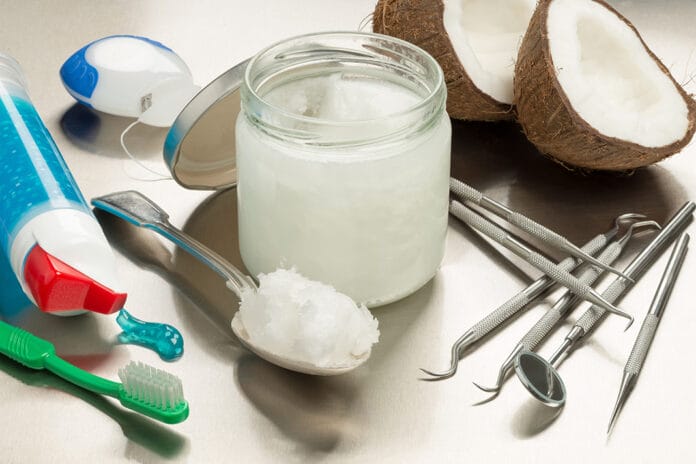Just when I think a popular dental trend has phased out, it gets rehashed, and I find it on a particular social media platform daily. Oil pulling has always been a trend that I find senseless and unnecessary. Yet, thousands of people continue to practice and promote this oral hygiene regimen.
Oil pulling dates back 3,000 to 5,000 years ago in ancient India in Ayurvedic medicinal texts.1,2 Ayurvedic is a holistic approach to medicine. According to many online sites, two different traditional methods are used to practice oil pulling. In Kavala Graha, a small amount of oil is placed in the mouth, swished and pulled through the teeth for three to five minutes, gargled, and then expectorated.1 In Gandusha, the entire mouth is filled with oil, swished, pulled for three to five minutes, and then expectorated.1 The viscous oil will turn milky white and thinner if performed correctly.3
Some resources on the internet suggest oil pulling for a duration of up to 20 minutes.3 However, Ayurvedic practitioner Dr. Nikhita states that many incorrectly practice oil pulling.4 She states that one should first brush their teeth and scrape the tongue to remove oral plaque. Then she demonstrates what appears to be a tablespoon of oil, placed in the mouth and held (not swished) until lacrimation or the feeling that you can’t hold it anymore, and then expectorated.4
According to The Indian Express, oil pulling should be practiced on an empty stomach as it is believed to help encourage a healthy diet and enhance taste.5
Commonly used oils are sesame, sunflower, or coconut.2 Dr. Nikhita specifically recommends sesame oil as she believes it nourishes, detoxifies, and strengthens the gingival tissue.4 Sesame oil is coined the “King of Oils” for its rich nutrient values and versatility.5
However, one study revealed sesame oil did not have any antibacterial effect against oral microorganisms like S. mutans, S. mitis, and S. viridans.6 Of the trending videos and posts circulating, it appears that coconut oil is the current favorite among oil pullers. Coconut oil gained its popularity due to its supposed antimicrobial benefits and lauric acid content.4 Lauric acid has proven anti-inflammatory and antimicrobial effects.5,7
Per the Indian Ministry of Ayush, oil pulling has been used to prevent decay, oral malodor, gingival bleeding, dryness of the throat, and cracked lips and to strengthen the teeth, gingiva, and jaw.4 The process of oil pulling is believed to cure or control 30 different types of systemic diseases, including headaches and chronic diseases such as asthma and diabetes mellitus.2
Any True Oral Health Benefits?
Multiple studies have been conducted over the years, but based on the lack of evidence, the American Dental Association still does not recommend oil pulling as a dental hygiene practice.8
A 2023 systematic review of the literature on the efficacy of oil pulling in improving gingival health, plaque control, and bacteria counts against chlorhexidine and other mouthwash or oral hygiene practices found some studies showed probable effectiveness in improving oral health with oil pulling. However, these reports go on to state that, in comparison, chlorohexidine remained superior in reducing plaque, and further studies would need to be conducted to support this regimen.9
This systematic review concluded that “all the reported studies were presented with high risk of bias, particularly on small sample sizes and the effect of adhering to intervention throughout the study period. Therefore, the current review suggested a very low certainty of the clinically beneficial effect in favour of oil pulling over chlorhexidine or other oral hygiene practice.”9
Risks of Oil Pulling
While oil pulling does not pose any immense danger, it does not come without risk. When swishing for long periods of time, as many suggest and practice with oil pulling, the temporomandibular joint (TMJ) can be affected. Some TMJ specialists do not recommend even using casual mouthwash if you suffer from a TMJ disorder.10
While unlikely, a risk exists of aspiration or inhalation of the oil into the lung cavities, which can lead to exogenous lipoid pneumonia. Exogenous lipoid pneumonia occurs from a collection of lipid-containing products within the lungs. Although thought to be a rare condition, the incidence of this particular type of pneumonia is growing exponentially in all age groups secondary to the phenomena termed “vaping,” which occurs from the inhalation of aerosols from electronic cigarettes.11
Currently, there is no standard of care for exogenous lipoid pneumonia, but cessation of the causative agent must occur immediately after diagnosis.11 Prognosis varies and is contingent on age and time of diagnosis.11
While not a health risk, expectorating oil into the sink will eventually clog the drain pipes. It is advisable to expel the oil into the trash instead.
In Closing
After nearly 20 years of practicing dental hygiene, it amazes me when I hear of someone participating in oil pulling. So many patients fail even to make an effort to brush the full two minutes twice daily, yet because they ran across a TikTok video of a random person making a claim to the validity of oil pulling, they are suddenly spending 10-plus minutes doing it themselves.
While I am not completely against it, I find oil pulling unnecessary to obtain optimal oral health. Personally, if patients would simply brush twice daily, clean interdentally, and see their dental professional regularly, they could save themselves much time and come out with even better results.
Before you leave, check out the Today’s RDH self-study CE courses. All courses are peer-reviewed and non-sponsored to focus solely on high-quality education. Click here now.
Listen to the Today’s RDH Dental Hygiene Podcast Below:
References
- What is Oil Pulling, And Does It Actually Work? (2019, February 11). Westside Family Dentistry. https://www.westsidefamilydentistry.com/blog/2019/2/11/what-is-oil-pulling-and-does-it-actually-work/
- Naseem, M. Khiyani, M.F., Nauman, H., et al. Oil Pulling and Importance of Traditional Medicine in Oral Health Maintenance. International Journal of Health Sciences. 2017: 11(4): 65-70. https://www.ncbi.nlm.nih.gov/pmc/articles/PMC5654187
- Shanbhag, V.K.L. Oil Pulling for Maintaining Oral Hygiene – A Review. Journal of Traditional and Complementary Medicine. 2017; 7(1):106-109. https://www.sciencedirect.com/science/article/pii/S2225411016300281
- Lifestyle Desk. (2021, August 31). Oil Pulling: Are You Doing It Right as per Ayurveda? The Indian Express. https://indianexpress.com/article/lifestyle/health/oil-pulling-ayurveda-gandusha-kavala-benefits-7472146/
- Oil Pulling 101: How to Oil Pull & the Science Behind It. (2023). Banyan Botanicals. https://www.banyanbotanicals.com/info/ayurvedic-living/living-ayurveda/lifestyle/how-to-do-oil-pulling/
- Asokan, S., Rathinasamy, T.K., Inbamani, N., et al. Mechanism of Oil-pulling Therapy – In Vitro Study. Indian Journal of Dental Research. 2011; 22(1): 34-37. https://journals.lww.com/ijdr/fulltext/2011/22010/mechanism_of_oil_pulling_therapy___in_vitro_study.8.aspx
- Peedikayil, F.C., Sreenivasan, P., Narayanan, A. Effect of Coconut Oil in Plaque Related Gingivitis – A Preliminary Report. Nigerian Medical Journal. 2015; 56(2): 143-147. https://www.ncbi.nlm.nih.gov/pmc/articles/PMC4382606/
- Oil Pulling. (n.d.). American Dental Association: MouthHealthy. https://www.mouthhealthy.org/all-topics-a-z/oil-pulling
- Jong, F.J.X., Ooi, D.J., Teoh, S.L. The Effect of Oil Pulling in Comparison with Chlorhexidine and Other Mouthwash Interventions in Promoting Oral Health: A Systematic Review and Meta‐analysis. International Journal of Dental Hygiene. 10.1111/idh.12725. Advance online publication. https://onlinelibrary.wiley.com/doi/full/10.1111/idh.12725
- What Causes Sudden TMJ pain? (n.d.). Columbia Center for Sleep Apnea & TMJ. https://www.columbiatmjandpain.com/what-causes-sudden-tmj-pain
- Beck, L.R., Landsberg, D. (2023, June 12). Lipoid Pneumonia. StatPearls. https://www.ncbi.nlm.nih.gov/books/NBK554577/











